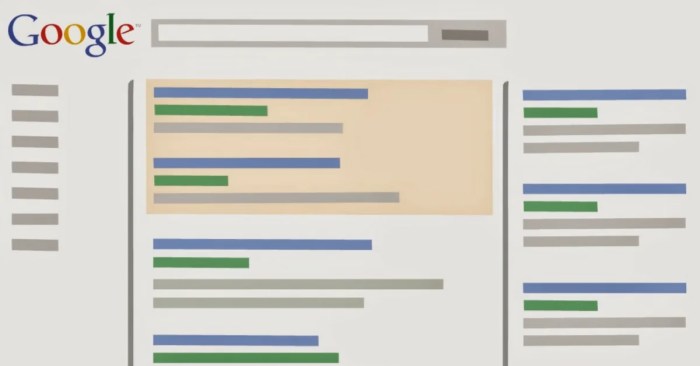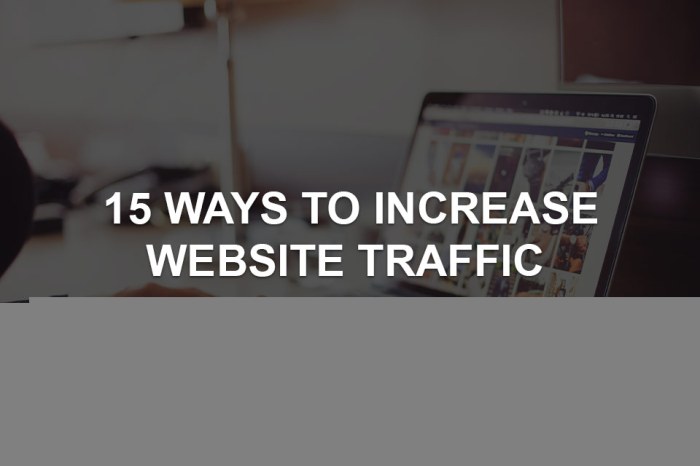Google Ad Pay-Per-Click Mastery
Google Ad pay-per-click advertising offers a powerful way to reach potential customers. This guide explores the fundamentals, from setting up basic campaigns to optimizing advanced strategies, providing a roadmap for maximizing your return on investment (ROI). Understanding the various ad formats, targeting options, and campaign types is key to success.
We’ll delve into the different ways to target potential customers, from basic targeting to more sophisticated techniques like in-market audiences and remarketing. Crucially, we’ll cover optimizing your campaigns through strategies for maximizing ROI, analyzing key performance indicators (KPIs), and refining ad copy to boost click-through rates. This detailed exploration will empower you to maximize your Google Ads budget.
Fundamentals of Google Ads Pay-Per-Click

Source: insightmultimedia.ie
Google Ads, formerly known as Google AdWords, is a powerful platform for businesses to reach potential customers online. The Pay-Per-Click (PPC) model is central to this platform, allowing advertisers to pay only when a user clicks on their ad. This model provides a targeted approach to advertising, ensuring that your budget is utilized effectively by only charging for genuine user engagement.
The core principle of PPC is that advertisers bid on keywords relevant to their business. When a user searches for those terms, their ad can appear prominently in search results or alongside relevant content. Successful PPC campaigns rely on meticulous research and effective ad copy.
Pay-Per-Click (PPC) Model Explained
The PPC model in Google Ads operates on a bidding system. Advertisers bid on keywords or phrases that users type into Google search. The highest bidder for a given keyword often appears at the top of the search results page, although other factors, such as quality score, also influence ad placement. Advertisers are only charged when a user clicks on their ad, hence the term “pay-per-click.” This targeted approach ensures that you’re only paying for actual engagement with your advertisement.
Ad Formats in Google Ads
Google Ads offers various ad formats to cater to diverse advertising needs. These formats include:
- Search Ads: These are the most common format, appearing prominently in search results. They are text-based and usually include snippets that match users’ searches.
- Display Ads: These ads appear on websites and apps within the Google Display Network. They can be image-based, video-based, or rich media ads, and often incorporate visuals to attract attention.
- Video Ads: These ads appear on YouTube and other video platforms. They can be short, engaging video clips designed to drive views and conversions.
- Shopping Ads: These ads display product information, images, and pricing directly within search results, allowing users to quickly browse and purchase products.
- App Ads: These ads promote mobile applications and appear on various Google platforms, driving downloads and app engagement.
Targeting Potential Customers
Google Ads allows for extensive targeting options, enabling advertisers to precisely reach their ideal customer base. These targeting methods include:
- Targeting: This involves targeting ads based on specific keywords or phrases. Advertisers can target broad or specific segments depending on their needs.
- Location Targeting: Ads can be displayed based on the geographical location of the user, allowing for targeted advertising in specific regions or countries.
- Demographic Targeting: This focuses on targeting users based on their age, gender, income, and other demographic characteristics.
- Interest Targeting: This approach targets users based on their interests and hobbies, enabling advertisements to appear on sites related to their passions.
- Remarketing: This allows for targeting users who have previously interacted with your website or app, enabling retargeting to encourage conversions.
Setting Up a Basic Google Ads Campaign
Creating a basic Google Ads campaign involves several key steps:
- Account Setup: Set up your Google Ads account, providing the necessary business information.
- Campaign Creation: Define your campaign goals, budget, and target audience. Choose the relevant ad formats.
- Research: Identify relevant search terms that potential customers use to search for products or services similar to yours.
- Ad Copy Creation: Craft compelling ad copy that accurately reflects your offerings and persuades users to click.
- Budget and Bidding Strategy: Determine your daily budget and choose a bidding strategy (e.g., manual bidding, automated bidding).
- Targeting: Specify the location, demographics, interests, and other targeting parameters.
- Monitoring and Optimization: Track campaign performance and adjust s, bids, and ad copy to optimize for better results.
Creating Effective PPC Ad Copy
Crafting effective PPC ad copy is crucial for driving clicks and conversions. Here’s a structured approach:
- Compelling Headline: The headline should be concise, relevant, and immediately grab the user’s attention. Use strong action verbs and s.
- Clear Description: Provide a concise and accurate description of your product or service. Highlight key benefits and address the user’s needs.
- Call to Action (CTA): Include a clear and compelling call to action (e.g., “Shop Now,” “Learn More,” “Get a Quote”).
- Relevant s: Incorporate relevant s throughout the ad copy to improve relevance and visibility.
Optimizing Pay-Per-Click Campaigns
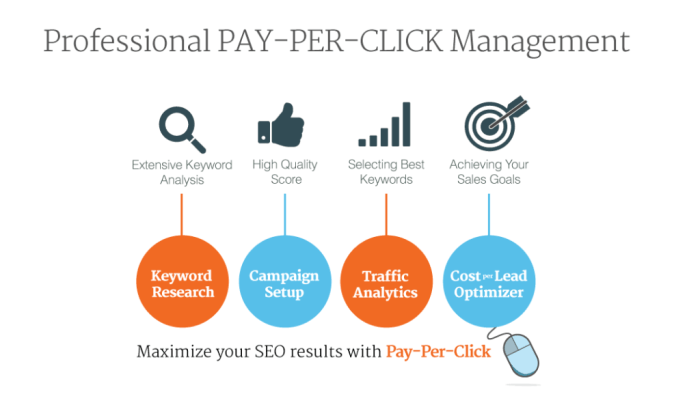
Source: pyxl.com
PPC campaigns, while offering direct access to potential customers, demand meticulous optimization to achieve a high return on investment (ROI). Effective optimization hinges on a deep understanding of campaign performance, coupled with strategies for enhancing ad relevance and efficiency. A well-structured approach, utilizing insightful data analysis and strategic bidding, is crucial for success.
Understanding the intricacies of PPC campaign performance is essential to maximizing ROI. This involves identifying key performance indicators (KPIs) that reveal the effectiveness of various strategies and adjusting tactics accordingly. Analyzing campaign data, coupled with the implementation of appropriate bidding strategies, will significantly influence the profitability of PPC campaigns.
Maximizing Return on Investment (ROI)
To maximize ROI, it’s crucial to focus on the elements that directly impact conversions. This includes refining targeting parameters to ensure that ads reach the most qualified prospects. A/B testing different ad copy variations is an effective way to identify which messaging resonates best with the target audience, driving higher click-through rates and conversions. Optimizing landing pages for seamless user experiences, ensuring fast loading times, and intuitive navigation, is also vital for driving conversions. Robust tracking mechanisms are crucial for monitoring the effectiveness of different aspects of the campaign and identifying areas for improvement.
Key Performance Indicators (KPIs) for Measuring PPC Campaign Success
A comprehensive set of KPIs is necessary to assess campaign performance accurately. Click-through rate (CTR) reveals how effectively ads capture user attention. Conversion rate (CVR) measures the percentage of clicks that lead to desired actions, such as purchases or sign-ups. Cost per conversion (CPC) provides a crucial metric for evaluating the efficiency of ad spend. Return on ad spend (ROAS) demonstrates the profitability of the campaign by showing the revenue generated for every dollar spent. By tracking these KPIs, advertisers can pinpoint areas needing improvement and make data-driven adjustments.
Analyzing and Interpreting PPC Campaign Data, Google Ad Pay-Per-Click
Analyzing campaign data is vital for identifying patterns and trends. Tools like Google Ads provide detailed reports that break down campaign performance across various dimensions, including demographics, location, and device. Analyzing these reports allows advertisers to identify high-performing ads, ad copy, and landing pages. Interpreting these data points reveals opportunities to refine campaigns for better results. The goal is to understand which aspects of the campaign are driving conversions and which are not, allowing for targeted adjustments.
Methods for Analyzing and Interpreting PPC Campaign Data
A key component in analyzing PPC campaign data is the use of tools that provide comprehensive reports. These reports often include data on demographics, location, and device, offering valuable insights into campaign performance. The analysis should identify high-performing, ad-coadsy, and landing pages. By interpreting these findings, advertisers can pinpoint areas needing improvement.
Common PPC Bidding Strategies
Different bidding strategies cater to various business needs and goals. Choosing the appropriate strategy depends on the specific objectives and budget constraints.
| Bidding Strategy | Description |
|---|---|
| Manual Bidding | Advertisers set bids for S manually, allowing for precise control over costs and targeting. |
| Automated Bidding | Google Ads automatically adjusts bids to maximize conversions or minimize cost-per-acquisition (CPA). This approach streamlines management and often yields positive results, particularly for large campaigns. |
| Target CPA | Sets a target cost per acquisition, and Google Ads adjusts bids to try to meet that target. |
| Maximize Conversions | Focuses on maximizing the number of conversions while keeping the cost-per-conversion as low as possible. |
Improving Ad Relevance
Ad relevance is a critical factor in PPC campaign success. Matching ad copy to the specific search query improves CTR and decreases costs. Using specific keywords in ad copy is important for targeting the right audience. Ensuring the landing page is closely aligned with the ad copy further enhances relevance and user experience. This consistency builds trust and encourages conversions.
Advanced Google Ads Strategies: Google Ad Pay-Per-Click
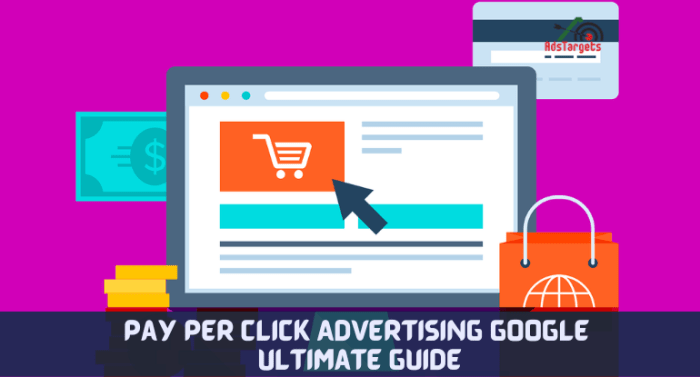
Source: adstargets.com
Mastering advanced strategies unlocks deeper insights into your target audience and allows for more precise campaign management, boosting your return on investment (ROI). By implementing these techniques, you can refine your campaigns to reach the right people at the right time, optimizing your budget and maximizing conversions.
Beyond the basics, advanced Google Ads strategies involve sophisticated targeting methods, meticulous quality score management, and strategic budget allocation. Understanding and applying these methods will help you refine your approach and achieve greater campaign success.
Advanced Targeting Techniques
Advanced targeting allows you to pinpoint specific segments of your audience. In-market audiences identify users actively researching or considering products or services similar to yours. Remarketing targets users who have previously interacted with your website, allowing you to re-engage them with tailored ads. These strategies are crucial for focusing your ad spend on the most receptive audience.
Quality Score Optimization
Quality Score significantly impacts your ad’s position and cost-per-click. A high Quality Score indicates to Google that your ads are relevant and useful to users, leading to better ad placement and lower costs. Several factors contribute to a high Quality Score, including a well-written ad copy, a relevant landing page, and a strong strategy. A higher Quality Score often translates into better ad visibility and reduced costs.
Creating and Managing a Successful Google Ads Budget
A well-structured Google Ads budget is vital for campaign success. It’s essential to allocate funds effectively across various campaign types. A step-by-step approach involves defining clear campaign goals, setting realistic budget limits, and monitoring performance regularly. Adjustments to the budget should be made based on campaign data and performance metrics. This iterative approach is crucial for optimizing your budget allocation over time. Constantly monitor key performance indicators (KPIs) such as click-through rates (CTR) and conversion rates. Adjustments to your budget can be made based on performance. Tracking your spending against your budget allows you to make informed decisions to improve your campaign’s efficiency.
Comparing Campaign Types
Different campaign types cater to various marketing objectives. Search campaigns target users actively searching for specific items. Display campaigns utilize visually engaging ads across a vast network of websites and apps. Video campaigns leverage engaging video formats to connect with audiences. Understanding the strengths and weaknesses of each campaign type is essential for selecting the right approach for your specific needs.
- Search Campaigns target users actively searching for specific keywords related to your business. They are effective for reaching customers in the immediate buying cycle. Examples include customers searching for “best running shoes” or “affordable laptops.”
- Display Campaigns use visually engaging ads across a broad network of websites and apps. They are excellent for branding and reaching a wider audience, even those not actively searching. Examples include banner ads on news websites or social media platforms. Display campaigns allow for greater flexibility in targeting.
- Video Campaigns leverage video formats to connect with audiences. They are particularly effective for showcasing products or services and are suitable for brand awareness campaigns. Examples include product demos or animated explanations.
PPC Ad Extensions
Ad extensions enhance your ad visibility and provide more information to potential customers. They include sitelink extensions, callout extensions, and location extensions. A well-structured set of extensions can significantly improve your ad’s performance.
| Extension Type | Description | Benefit |
|---|---|---|
| Sitelink Extensions | Provide links to specific pages on your website | Increases click-through rates by offering users more options. |
| Callout Extensions | Highlight key benefits or features of your product or service | Enhances ad relevance and provides more information to potential customers. |
| Location Extensions | Display your business location on the map | Helps users find your business easily and increases relevance to local searches. |
| Structured Snippets Extensions | Provide a structured list of key features or services. | Offer a concise summary of your products or services, boosting clarity and appeal. |
| Call Extensions | Provide a clickable phone number for direct contact | Facilitates immediate communication and increases conversions for businesses relying on phone calls. |
PPC Best Practices and Case Studies
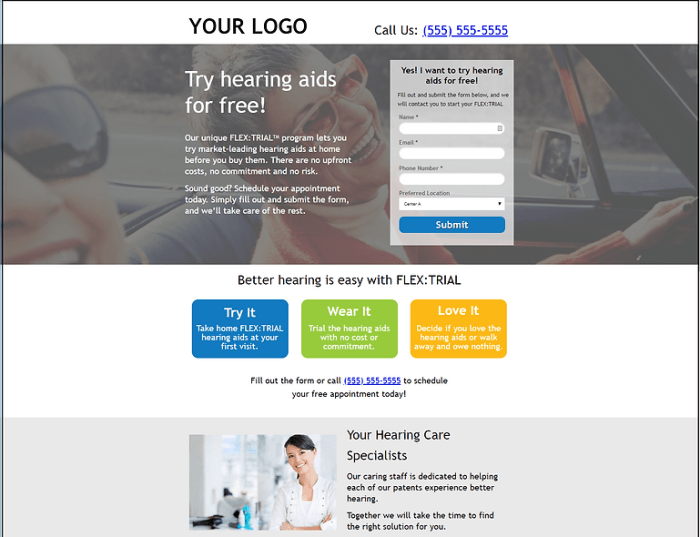
Source: wixstatic.com
PPC campaigns are crucial for driving targeted traffic and conversions. Implementing best practices and understanding successful strategies is key to maximizing ROI. This section explores key strategies and real-world examples, highlighting effective measurement and ongoing optimization.
Compelling PPC Ad Creation
Crafting compelling ads is paramount to capturing user attention and driving clicks. Effective ads combine clear value propositions, relevant content, and compelling language. A well-structured ad copy should instantly communicate the value proposition to the target audience.
- Relevance: Utilize highly relevant snippets that accurately reflect the search intent of your target audience. Avoid generic or broad terms. Using specific and targeted search terms increases the chances of your ads appearing to users actively seeking the products or services you offer.
- Clear Value Proposition: Immediately communicate the value your product or service offers to the user. Highlight key benefits, such as cost savings, improved efficiency, or enhanced quality. Clearly articulate what problem you solve for the user.
- Compelling Language: Use persuasive language to encourage clicks. Focus on addressing user needs and pain points. Avoid jargon or overly technical language. Emphasize the value proposition in a way that resonates with the target audience’s needs and desires.
- Strong Call to Action (CTA): Include a clear and concise call to action that directs users to the desired next step, such as making a purchase, requesting a quote, or visiting a landing page. Use compelling action verbs to inspire immediate action.
Successful Google Ads Campaigns
Numerous successful campaigns across diverse industries demonstrate the power of strategic PPC management. These campaigns showcase how specific strategies can yield significant results.
- E-commerce: Retailers have effectively used targeted ads to drive sales of specific products or categories. They often utilize dynamic remarketing campaigns to re-engage users who have previously interacted with their website. Example: A clothing retailer targeting users interested in specific styles or brands through dynamic product ads.
- Real Estate: Real estate agents leverage location-based targeting and specific property features to attract potential buyers. Highlighting unique selling points (USPs) and including high-quality images or videos in the ad is crucial. Example: A real estate agency showcasing luxury properties with stunning visuals and detailed descriptions in their ads.
- Professional Services: Law firms, consulting firms, and other professional service providers use targeted ads to reach specific demographics and interests. Highlighting their expertise and experience in their respective fields is essential. Example: A law firm specializing in corporate law targeting business executives with specific legal needs.
Measuring Campaign Effectiveness
Measuring campaign effectiveness is crucial for optimizing performance. Key metrics, such as click-through rates (CTR), conversion rates, and cost-per-conversion (CPC), should be tracked and analyzed. Continuous monitoring and evaluation enable informed decisions about adjustments to the campaign.
- Click-Through Rate (CTR): CTR measures the percentage of impressions that result in clicks. A higher CTR indicates more effective ad copy and targeting. CTR provides a direct measure of ad effectiveness in attracting user attention.
- Conversion Rate: Conversion rate measures the percentage of clicks that result in desired actions, such as purchases or form submissions. A higher conversion rate signifies that the ad and landing page effectively convert leads into customers. Conversion rate is a key indicator of campaign success.
- Cost-Per-Conversion (CPC): CPC measures the cost incurred for each conversion. A lower CPC indicates greater efficiency in acquiring conversions. Lowering CPC is a crucial goal in optimizing campaign cost-effectiveness.
Ongoing Campaign Monitoring and Adjustments
Ongoing monitoring and adjustments are essential for optimizing campaign performance. Regular analysis of key metrics allows for timely adjustments to targeting, bidding strategies, and ad copy to maintain campaign effectiveness.
- Regular Analysis: Reviewing performance data regularly, such as daily, weekly, or monthly, is critical to identify trends and patterns. This allows for proactive adjustments to maintain campaign performance.
- A/B Testing: Testing different ad variations, such as different headlines, descriptions, and CTAs, can optimize performance. A/B testing provides valuable data to inform future campaign design.
- Targeting Refinement: Refine targeting based on performance data to ensure that ads are reaching the most relevant audience. This may involve adjusting demographics, interests, or location parameters.
Impact of Ad Copy Variations
Experimentation with different ad copy variations is a crucial aspect of PPC optimization. A/B testing can identify the most effective ad copy and messaging to maximize click-through rates. The table below illustrates the impact of variations on CTR.
| Ad Copy Variation | Click-Through Rate (%) |
|---|---|
| Variation 1 (Headline A, Description A) | 2.5 |
| Variation 2 (Headline B, Description B) | 3.2 |
| Variation 3 (Headline C, Description C) | 4.1 |
Final Summary
In conclusion, mastering Google Ad pay-per-click involves a blend of foundational knowledge and strategic optimization. From crafting compelling ad copy to implementing advanced targeting, this comprehensive guide has equipped you with the essential tools and techniques. By consistently monitoring your campaigns, analyzing data, and adapting to best practices, you can achieve significant success with your Google Ads strategy. Remember, ongoing refinement and a focus on measurable results are key to sustained success in the dynamic world of PPC.



